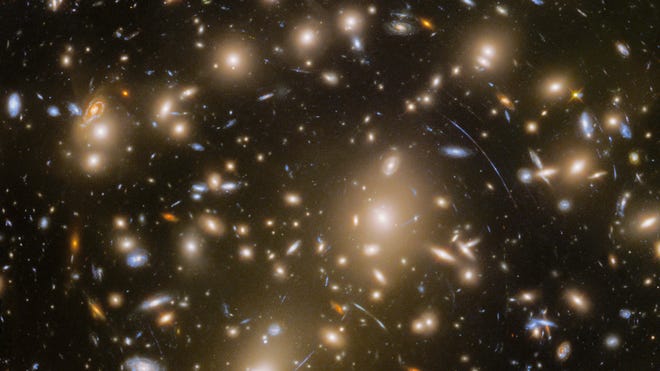- The team’s findings, which were published Monday in the journal Nature, also unveil a method of investigating dark matter, which remains one of the universe’s greatest mysteries.
Astronomers setting their sights halfway across the observable universe recently identified the largest amount of individual stars ever detected so far away – a feat once considered near-impossible.
To make the historic discovery, the team of researchers turned to NASA’s James Webb Space Telescope and its high-resolution power to reveal 44 individual stars in a galaxy so far away, that its light dates back to when the universe was half its age.
The discovery marks the largest number of individual stars ever detected in the distant universe. The team’s findings, which were published Monday in the journal Nature, also unveil a method of investigating dark matter, which remains one of the universe’s greatest mysteries, study co-author Fengwu Sun said.
“This groundbreaking discovery demonstrates, for the first time, that studying large numbers of individual stars in a distant galaxy is possible,” Sun, of the Center for Astrophysics, a research institute jointly operated by the Harvard College Observatory and Smithsonian Astrophysical Observatory, said in a statement.

2025 space launches:Uncrewed lunar missions and 1st private space station among 2025 space launches
Gravitational lensing unveils historic number of distant stars
Most galaxies, including our Milky Way, contain tens of billions of stars that are readily observable. Even in nearby galaxies, such as Andromeda, which is about 2.5 million light-years away, astronomers can observe stars one by one.
But when astronomers look at distant galaxies billions of light-years away, individual stars can appear fuzzy – blended as their light travels great distances to reach us on Earth. For that reason, astronomers have long struggled to study how distant galaxies form and evolve.
“To us, galaxies that are very far away usually look like a diffuse, fuzzy blob,” study lead author Yoshinobu Fudamoto, an astronomer at Chiba University in Japan, said in a statement. “But actually, those blobs consist of many, many individual stars.”
Thanks to recent scientific advances, astronomers are only now getting better at observing those individual distant stars. Using a technique called gravitational lensing, the team of researchers was able to make their historic stellar discovery in a distant galaxy located nearly 6.5 billion light-years from Earth.
As first predicted by Albert Einstein, gravitational lensing occurs when a massive celestial body causes a sufficient curvature of spacetime for the path of light around it to be visibly bent, as if by a lens. The effect can amplify the light of distant stars, making it possible for instruments like the Webb telescope to detect them.
Discovery found from Webb images of ‘Dragon Arc’ galaxy

The team of astronomers did not expect to find the trove of stars while studying Webb images of a galaxy known as the Dragon Arc.
Fortuitously, the light from the stars was magnified by a massive cluster of galaxies in front of it called Abell 370. The effect of gravitational lensing then stretched the Dragon Arc’s signature spiral into an elongated shape, “like a hall of mirrors of cosmic proportions,” according to the press release accompanying the research paper.
“When we processed the data, we realized that there were what appeared to be a lot of individual star points,” Sun said. “It was an exciting find because it was the first time we were able to see so many individual stars so far away.”
By studying the colors of each of the stars inside the Dragon Arc, the team concluded that many are red supergiants, similar to Betelgeuse in the constellation of Orion. While the Hubble Space Telescope was able to previously observe seven of the 44 stars detected, the Webb telescope’s ability to detect infrared wavelengths allowed astronomers to “resolve stars that were previously outside of our capability,” Sun said.
What’s more, the team believes the discovery of so many stars will help scientists better understand dark matter.
Will the landmark discovery prompt future observations?
The researchers hope their landmark discovery will prompt follow-up observations of magnified stars in both the Dragon Arc galaxy and other distant galaxies.
“These findings have typically been limited to just one or two stars per galaxy,” Fudamoto said. “To study stellar populations in a statistically meaningful way, we need many more observations of individual stars.”
Eric Lagatta covers breaking and trending news for USA TODAY. Reach him at [email protected]

